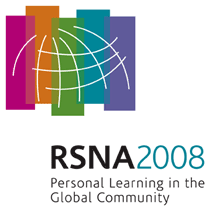
Abstract Archives of the RSNA, 2008
Anja Apel, Presenter: Intern, Siemens AG
Joel Garland Fletcher MD, Abstract Co-Author: Research grant, Siemens AG
Grant, E-Z-EM, Inc
License agreement, General Electric Company
Hassan Siddiki MD, Abstract Co-Author: Nothing to Disclose
James E. Huprich MD, Abstract Co-Author: Nothing to Disclose
David R. Holmes MD, Abstract Co-Author: Nothing to Disclose
Cynthia H. McCollough PhD, Abstract Co-Author: Research grant, Siemens AG
Research grant, RTI Electronics AB
Research grant, Bayer AG
Natalie N. Braun, Abstract Co-Author: Nothing to Disclose
Matthias Erich Bellemann PhD, Abstract Co-Author: Nothing to Disclose
Christian Eusemann PhD, Abstract Co-Author: Employee, Siemens AG
et al, Abstract Co-Author: Nothing to Disclose
Low tube voltage can be utilized to reduce radiation dose in small patients and increase the CNR of hypervascular lesions. We investigate the potential of dual energy CT to produce increased CNR in a phantom mimicking a large patient, using an image-based non-linear blending (NLB) of low and high kV images vs. a 0.3 linear blend (LB), which mimics CT attenuation values at 120 kV, across multiple dose settings.
A liver phantom was created using bovine liver containing 6 cc syringes (filled with iodine concentrations ranging from 15 to145 HU @ 140kV) submerged in an 30 cm diameter water bath and wrapped in Superflab® tissue-simulating material to a diameter of 40 cm. The phantom was scanned at 8 dose settings (45 to 115 mAs in increments of 10 mAs @ 140kV; 191 – 489 mAs at 80 kV). After optimizing visual contrast by adjusting the non-linear sigmoidal blending width and center, two readers measured the mean and standard deviation of CT numers over the liver, water and syringes to calculate the CNR (MeanSyringe - MeanLiver)/noiseWater). A LB ratio of 0.3 was chosen to simulate attenuation of standard 120 kV CT images. A Wilcoxon signed rank test was performed to determine signifance between CNR’s using sigmoidal blending vs. 0.3 LB approach.
There was no difference in CNRs between NLB and LB for 15 and 45 HU syringes (p=0.31 - 0.95). The LB resulted in better CNR for the 64 HU syringe (p-value of 0.008). The remaining 3 syringes had greater attenuation than the liver tissue HU (73 HU at 140kV), and demonstrated significantly better CNR’s using optimal sigmoidal blending compared to the 0.3 LB for both readers (p = 0.008 - 0.023). For all syringes with CT number greater than liver, the CNR for the sigmoidal blended images using a 191/45 mAs dose level (at 80/140 kV) was larger than the CNR for the LB images at all higher dose levels (up to 489/115 mAs).
In a liver phantom simulating a large patient, optimal sigmoidal blending of dual energy (80/140 kV) images by two readers resulted in higher CNR’s at lower dose levels, compared to 0.3 linear blending (which mimics attenuation at 120 kV).
Dual energy CT using optimum image-based, non-linear sigmoidal blending (of low and high kV images) can extend the benefits of low kV scanning (greater contrast, reduced dose) to larger patients.
Apel, A,
Fletcher, J,
Siddiki, H,
Huprich, J,
Holmes, D,
McCollough, C,
Braun, N,
Bellemann, M,
Eusemann, C,
et al, ,
Linear vs Nonlinear Dual Energy Blending: What Blending Technique Leads to a Better Contrast-to-Noise Ratio?. Radiological Society of North America 2008 Scientific Assembly and Annual Meeting, February 18 - February 20, 2008 ,Chicago IL.
http://archive.rsna.org/2008/6011658.html

